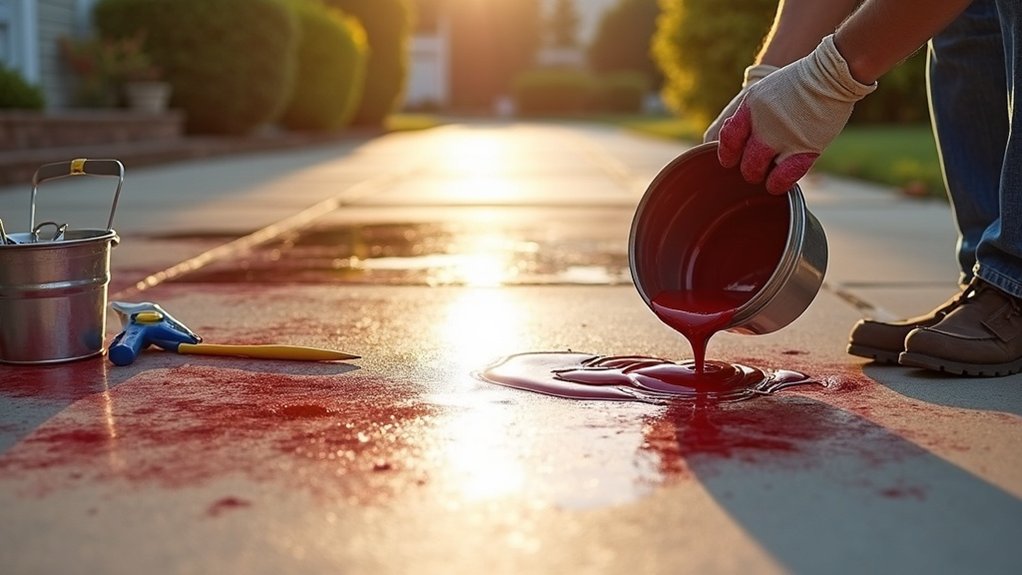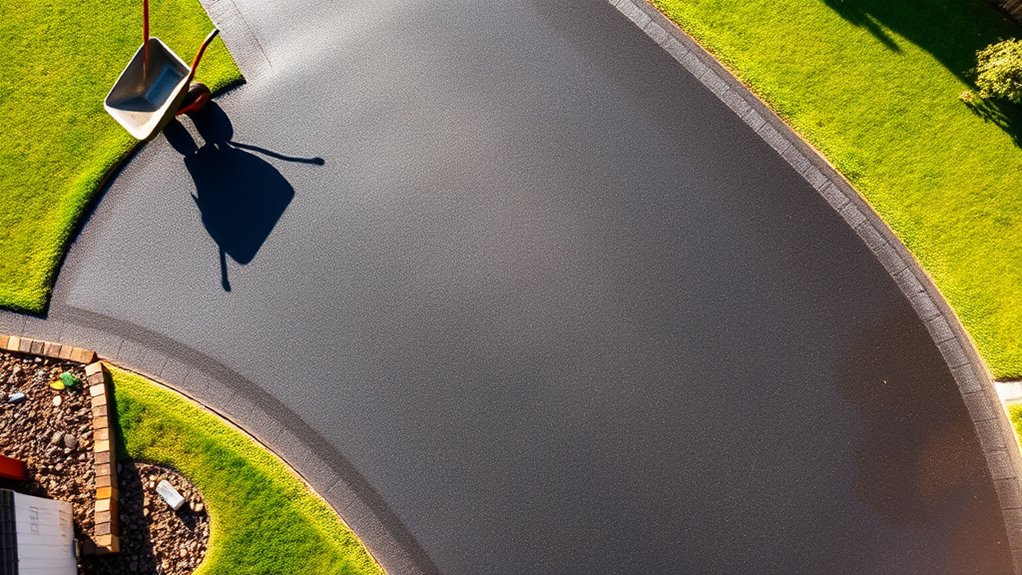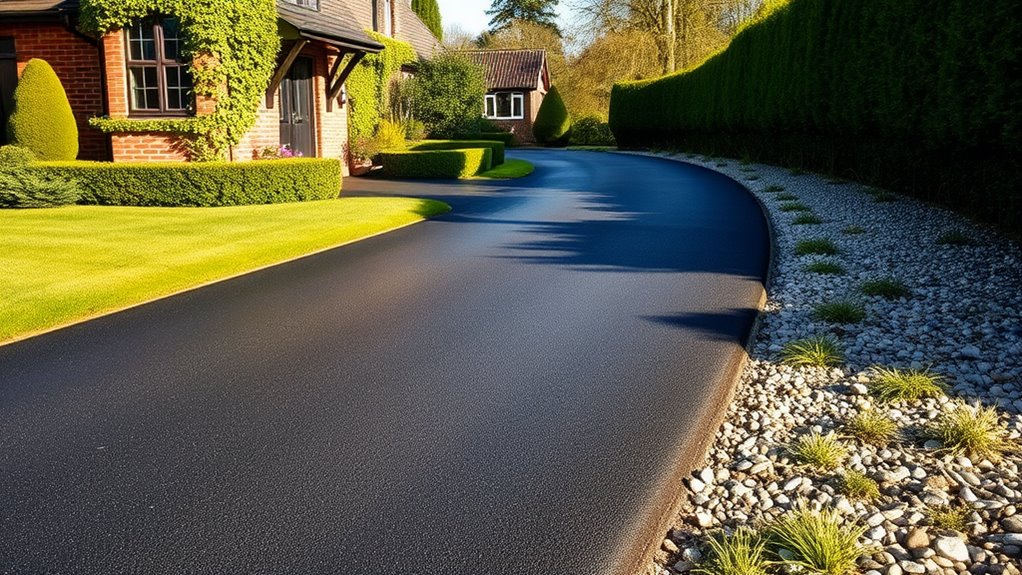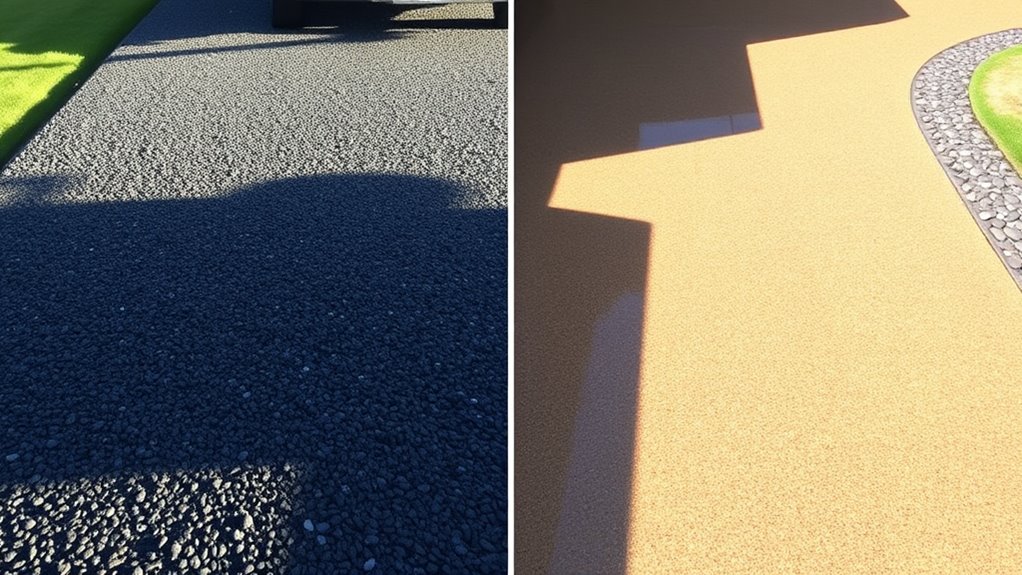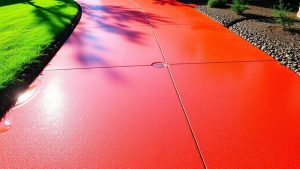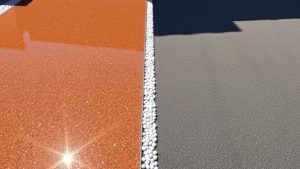Yes, you can stain a concrete driveway to improve its appearance. Begin by selecting a stain type, such as acid-based or water-based. Ensure the surface is clean and any damage is repaired before you start. Apply the stain evenly using a sprayer, making sure to keep a wet edge for a consistent finish. After staining, maintain the driveway with regular cleaning and reseal it every couple of years. Be mindful of the timing and weather conditions, as these can affect the results. Follow these steps for a visually appealing driveway.
Table of Contents
ToggleKey Takeaways
Yes, you can stain a concrete driveway using either acid-based or water-based stains to achieve various aesthetic effects.
Proper surface preparation is vital—ensure the concrete is clean, repaired, and etched for even stain absorption. Use pump sprayers for larger areas and brushes for the edges, keeping a wet edge as you go.
Allow sufficient drying time between coats: 2-4 hours for water-based stains and around 35 minutes for acid stains before neutralising.
To maintain the look of your driveway, clean it regularly and reseal every two years. This will help preserve the stain and keep your driveway looking its best.
Understanding the Types of Concrete Stains
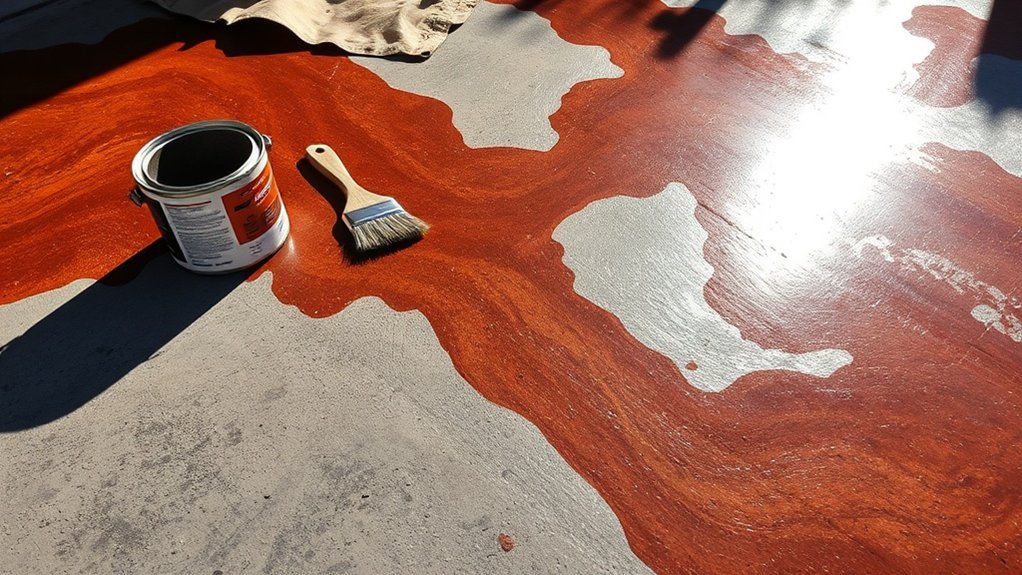
When considering staining your concrete driveway, it’s important to know the various types of stains available. Your choice will significantly affect both the look and durability of your driveway.
Acid-based stains penetrate the concrete, creating unique mottling effects in subtle earth tones, which can highlight imperfections. Additionally, stains are semi-transparent and may not cover surface imperfections.
In contrast, water-based stains offer a wider range of colours, including more vibrant options, and can be mixed for custom shades.
Concrete dyes provide intense, uniform colours, while opaque colour coatings offer solid coverage but may chip or peel over time.
Each option has its advantages, so think carefully about the desired appearance and how long you want it to last before making your decision.
Essential Surface Preparation Steps
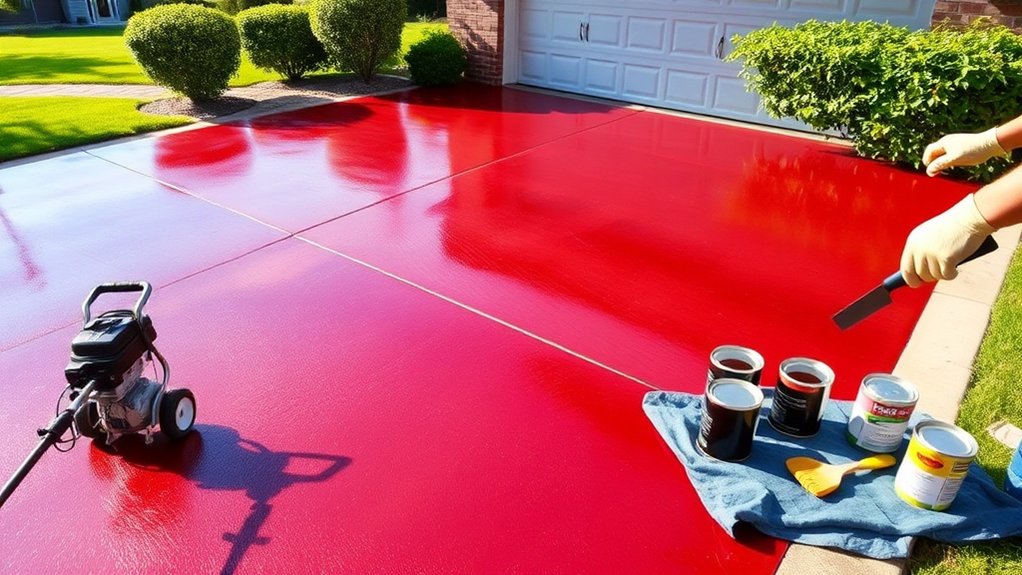
Preparing your concrete driveway for staining involves several crucial steps to ensure a smooth and durable finish. Start by assessing the surface porosity: spray water on the concrete; if it beads up, you’ll need to etch the surface. Next, clean the concrete thoroughly using a power washer or stiff brushes to remove any dirt or grease. Be sure to repair any cracks or chips to ensure an even stain application. Finally, allow the driveway to dry completely to avoid uneven colouring. A well-prepared surface leads to successful staining outcomes.
| Step | Key Action | Purpose |
|---|---|---|
| Assess | Spray water on the surface | Determine if etching is necessary |
| Clean | Power wash and degrease | Remove contaminants for better adhesion |
| Repair | Fill cracks and chips | Ensure a smooth finish |
| Etch | Use chemical etching solutions | Improve stain absorption |
| Drying | Allow 24-48 hours | Prevent blotches during staining |
The Staining Application Process
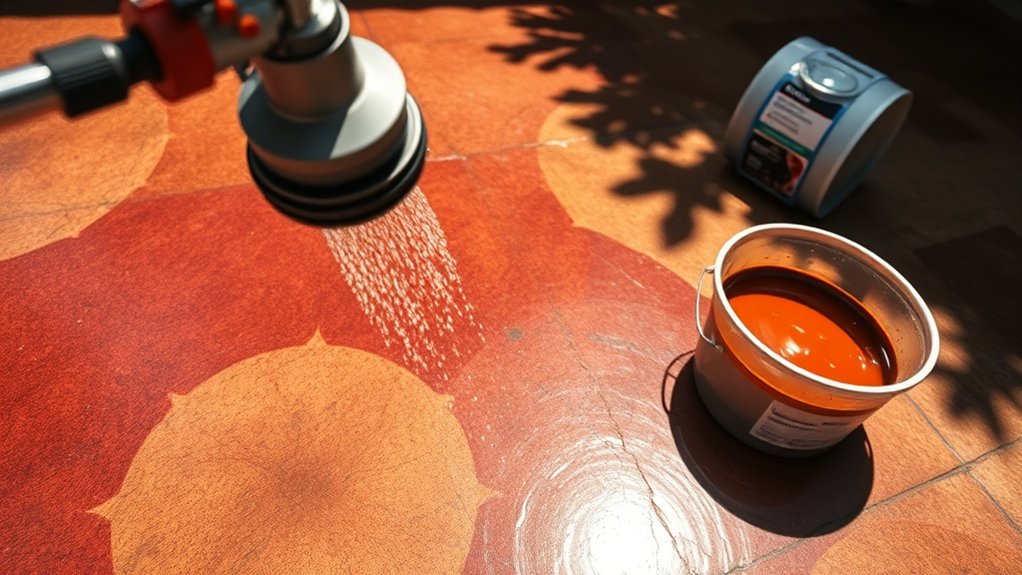
Staining your concrete driveway can significantly improve its look and durability. To get the best results, follow these steps:
- Stain Selection: Opt for acid-based stains for rich, earthy tones or water-based stains for a wider range of colours.
- Preparation: Ensure the surface is clean. If using water-based stains, open the pores for even penetration. Thorough surface preparation is essential for both new and old concrete.
- Application Techniques: Use pump sprayers for larger areas and brushes for edges. Apply in thin coats, keeping a wet edge to avoid puddles.
- Timing: Allow 35 minutes for acid stains to react before neutralising. Wait 2-4 hours between coats to check the colour development.
Post-Staining Care and Maintenance
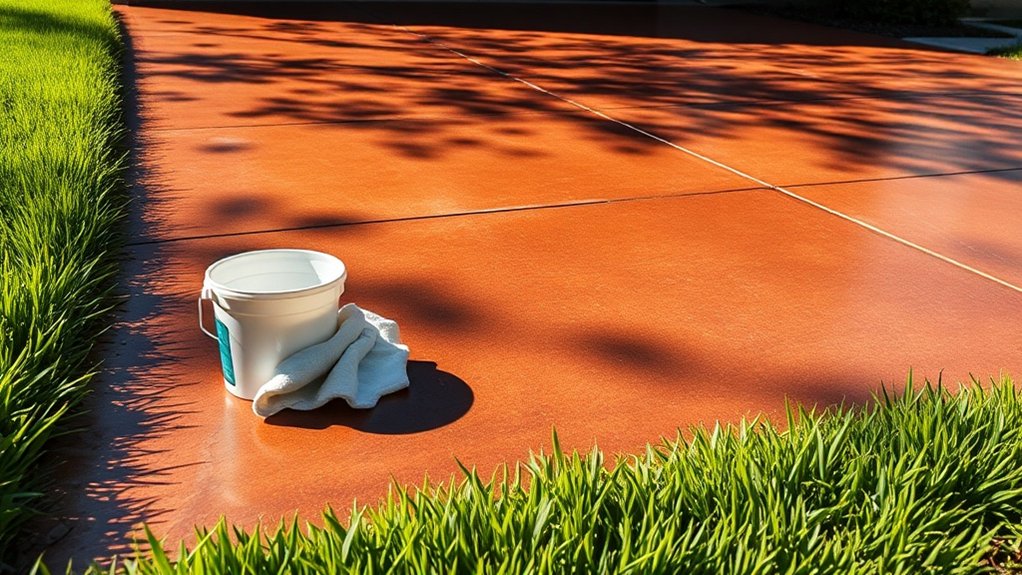
To keep your stained concrete driveway looking great and lasting longer, regular maintenance is key.
Start with cleaning: sweep and wash the surface regularly to stop dirt and debris from building up. If you spill oil or grease, clean it up promptly using absorbent materials and pressure wash with a medium setting to minimise stains.
After cleaning, think about applying a sealant to protect the surface and boost its colour. Reseal your driveway about every two years, or sooner if you notice wear.
Avoid using harsh chemicals as they can damage the stain, and regularly check for cracks or chips.
To maintain its appearance and durability, protect your driveway from heavy objects and excessive sun exposure.
With consistent care, your driveway will remain in top condition for years to come.
Timing and Curing Considerations
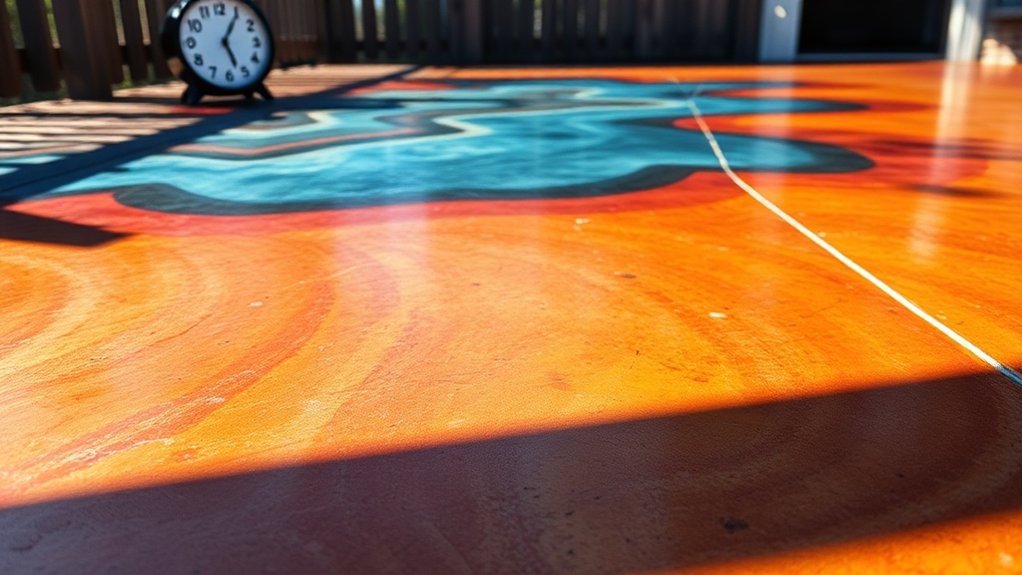
When planning your concrete driveway staining project, timing and curing are crucial for achieving the best results. Here are some key points to consider:
- Curing Duration: New concrete should cure for at least 28 days, and ideally up to 6 months, to ensure proper stain adhesion.
- Humidity Effects: The best conditions for staining are low humidity and moderate temperatures (10°C to 30°C) to avoid moisture issues.
- Seasonal Timing: The autumn and spring months are ideal for staining, as summer heat can cause the stain to dry too quickly.
- Surface Preparation: Always pressure wash the surface and allow at least 48 hours for drying before applying the stain, ensuring even penetration and durability.
Frequently Asked Questions
Can I Use a Colored Sealer After Staining My Driveway?
Yes, you can apply a coloured sealer after staining your driveway. Select a suitable colour sealer and follow the proper application methods. Ensure the surface is clean to improve adhesion and enhance colour protection. For instance, if you’ve stained your driveway a rich terracotta, a matching coloured sealer can deepen the hue and provide added durability.
How Long Will the Stain Last on My Driveway?
“An ounce of prevention is worth a pound of cure.” The longevity of stains on your driveway can vary; with proper care, you can expect them to last between 5 to 25 years. Regular cleaning and resealing will help maintain their appearance, ensuring your driveway remains vibrant for longer.
Is It Safe to Stain a Driveway in Winter?
Staining a driveway in winter isn’t advisable. Cold temperatures can impact the curing and adhesion of the stain, resulting in patchy colour and peeling. It’s best to wait for warmer months to ensure a proper finish.
Can I Mix Different Stain Colors for a Custom Look?
Yes, you can mix different stain colours for a distinctive custom finish! Experiment with blending stains to create unique patterns. Just be sure to test your combinations on a small area first to ensure you achieve the desired effect.
What if My Driveway Has Previously Been Sealed or Stained?
If your driveway has been sealed or stained before, you’ll need to prioritise removing any old stains and preparing the surface properly. This step is crucial, as getting rid of old sealers allows for better absorption of new stains and ensures a more uniform colour application.
Conclusion
Ready to transform your dull concrete driveway into something striking? With the right stains, preparation, and technique, you can create a vibrant look that enhances your home’s curb appeal. Just remember to maintain it afterwards—your driveway deserves proper care! By following these steps, you’ll create an impressive entrance that will catch the eye of visitors. Let’s get started!
How can a tarmac driveway enhance your home's appeal? Discover the key aspects of cost, installation, and maintenance in our Read more
Wondering if a tarmac driveway is the perfect fit for your home? Uncover the essential pros and cons before making Read more
Choosing between a tarmac and resin driveway can be challenging; discover the key factors that could influence your decision.

